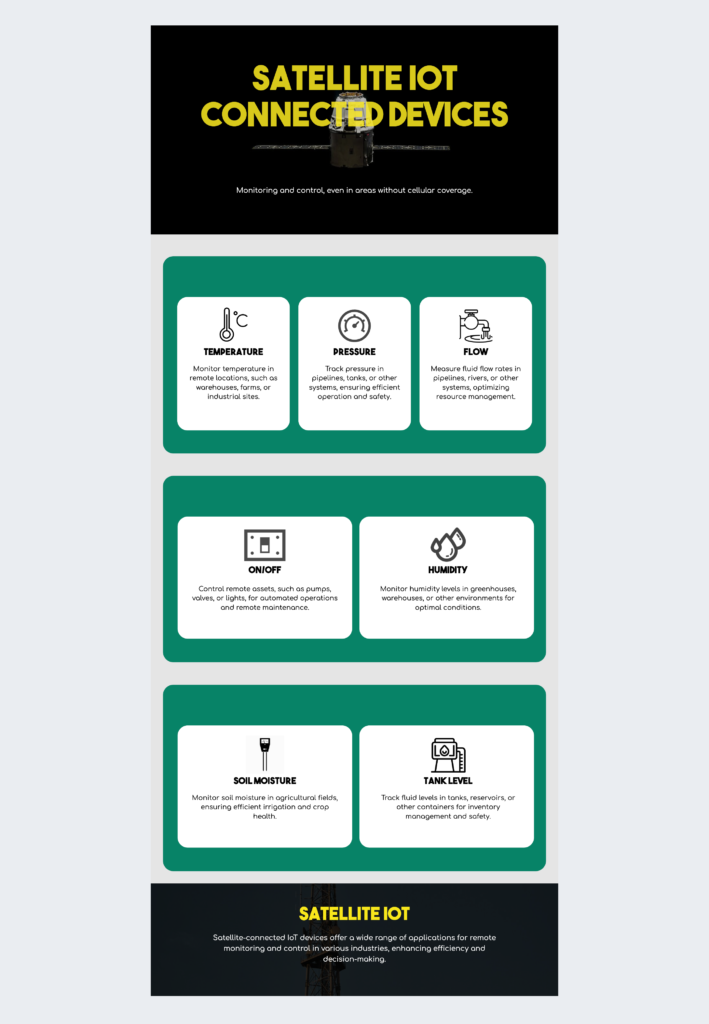The early entrants in the satellite IoT ecosystem capitalized on the growing need for seamless, global connectivity. Some of the most notable first-to-market devices include:
Iridium Edge
Developed by Iridium Communications, the Iridium Edge series delivers reliable satellite connectivity for asset tracking, fleet management, and industrial applications. With global reach and ease of integration, it became a pivotal product for industries needing real-time data from remote areas.
Inmarsat BGAN M2M Terminals
Inmarsat’s Broadband Global Area Network (BGAN) provided early satellite IoT solutions for monitoring assets and environmental conditions in remote regions. Its reliability in extreme conditions made it popular among mining, oil, and utilities sectors.
Orbcomm Devices
Orbcomm pioneered satellite-enabled IoT by offering devices tailored for cold chain monitoring, maritime tracking, and heavy equipment management.
Globalstar SmartOne Series
Globalstar entered the market with its SmartOne satellite trackers designed for asset management, offering compact, low-power devices for remote monitoring.
Key Business Verticals
Satellite IoT devices serve a wide range of industries. The most significant verticals include:
Agriculture
IoT-enabled precision agriculture is one of the largest markets for satellite IoT. Devices monitor soil moisture, crop health, weather conditions, and livestock tracking in rural or underserved regions. Companies like SatSure and FarmBeats (Microsoft) use satellite IoT to deliver actionable insights to farmers globally.
Maritime and Logistics
Satellite IoT is indispensable for vessel tracking, port operations, and cargo monitoring. Sensors on containers and ships ensure efficient logistics management across oceans. Companies like Orbcomm and Inmarsat dominate this space.
Energy and Utilities
In energy production and distribution, IoT sensors monitor pipelines, oil wells, and power grids in remote locations. These devices enhance operational safety and optimize resource utilization.
Environmental Monitoring
Governments and environmental organizations deploy satellite IoT devices to monitor natural ecosystems, track wildlife migration, and collect climate data. Applications range from monitoring deforestation to tracking endangered species.
Defense and Public Safety
Satellite IoT devices support disaster management, military operations, and emergency response in regions with limited connectivity.
Mining and Construction
These industries rely on satellite IoT for monitoring heavy equipment, ensuring worker safety, and managing resource extraction processes in remote environments.
Common Sensor and Devices in Satellite IoT

Satellite IoT devices integrate a diverse range of sensors, including:
- GPS and GNSS Sensors: For precise location tracking and geospatial monitoring.
- Environmental Sensors: Measure temperature, humidity, air quality, and pressure, essential for agriculture, environmental monitoring, and industrial applications.
- Motion and Vibration Sensors: Monitor movement and vibration in vehicles, heavy equipment, and infrastructure.
- Flow Sensors: Used in pipelines and water systems to track the flow rate and detect leaks.
- Proximity and Distance Sensors: Critical for automation and monitoring applications in mining and logistics.
- Chemical and Gas Sensors: Monitor emissions, detect hazardous substances, and ensure workplace safety in industrial settings.
Marketplaces for Satellite IoT Devices
Satellite IoT devices are sold through various distribution channels, including:
- Direct Sales by Manufacturers
Companies like Iridium, Inmarsat, and Globalstar sell devices directly to enterprises and service providers. - IoT Solution Integrators
Integrators bundle satellite IoT devices with software and services to deliver turnkey solutions for specific industries. - E-commerce Platforms
Platforms like Amazon and Alibaba feature IoT devices for general users and small businesses. Oranisations like The LoRa ALliance and the - Industry-Specific Vendors
Specialized vendors cater to niche markets such as maritime logistics, agriculture, or energy. - Partnerships with Telecom Providers
Telecom companies partner with satellite IoT firms to extend their services into remote areas, enhancing their value proposition.
Future Prospects for Satellite IoT Devices
The future of satellite IoT devices looks promising, driven by advancements in satellite technology, cost reductions, and increased demand for global connectivity. Key trends shaping the decade ahead include:
- Proliferation of Low Earth Orbit (LEO) Satellites
Companies like SpaceX (Starlink), Amazon (Project Kuiper), and OneWeb are deploying LEO constellations to provide faster, low-latency connections for IoT devices. These networks will drastically expand satellite IoT adoption by lowering costs and improving performance. - Miniaturization and Cost Reduction
Advances in device design and manufacturing are making satellite IoT devices smaller, cheaper, and more energy-efficient, enabling mass adoption in cost-sensitive industries. - Integration with 5G Networks
Hybrid 5G-satellite IoT networks will bridge connectivity gaps, ensuring seamless transitions between terrestrial and satellite coverage for real-time applications. - AI and Edge Computing
Incorporating AI and edge processing into satellite IoT devices will enable real-time analytics, anomaly detection, and predictive maintenance, reducing reliance on cloud computing. - Sustainability and Climate Monitoring
As climate change mitigation becomes a global priority, satellite IoT devices will play a crucial role in monitoring environmental changes, reducing emissions, and supporting renewable energy deployment. - Global Standardization
Emerging standards for satellite IoT communication (such as NTN-IoT in 5G) will facilitate interoperability between devices, networks, and services, accelerating adoption. - Growing IoT Ecosystem
The convergence of satellite IoT with other technologies like blockchain for secure data transmission or digital twins for simulation will unlock new applications across industries.
Conclusion
Satellite IoT devices are set to revolutionize connectivity by enabling monitoring and data collection in the most remote corners of the globe. From early pioneers like Iridium and Orbcomm to the rise of LEO constellations, the industry is poised for exponential growth. As costs decrease and technology advances, satellite IoT will penetrate new markets, empower industries, and contribute to solving global challenges. Over the next decade, the seamless integration of terrestrial and satellite IoT networks will usher in a truly interconnected world.